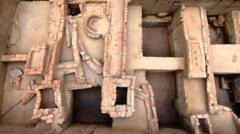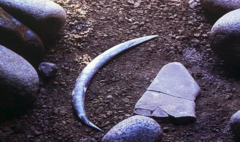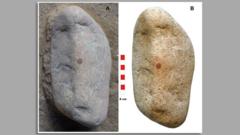In a stunning archeological landscape in Keeladi, Tamil Nadu, recent excavations have unveiled artifacts that challenge long-held beliefs about the origins of civilization in the Indian subcontinent. These findings, deep beneath layers of soil, include terracotta pots, burial urns, and intricate brick structures, suggesting an advanced society that thrived approximately 2,500 years ago. With evidence pointing to urban organization and literacy, the site has transformed into a political symbol, inciting discussions on heritage, identity, and regional pride.
Keeladi’s excavation journey began when Amarnath Ramakrishnan from the Archaeological Survey of India identified the village as a site of significance in 2013. It was within proximity to ancient Madurai and marked by earlier discoveries of pottery. Since then, the Tamil Nadu State Department of Archaeology's work has unveiled over 15,000 artifacts, revealing the dynamics of a long-hidden urban settlement. Ajay Kumar, who leads the excavation team, emphasizes the significance of discovering a society characterized by specialized spaces for habitation and industry.
These findings have revitalized discourse on India's historical narrative, often dominated by northern narratives of civilization. A sentiment echoed by locals like William Daniel, who expresses pride in a southern heritage that rivals northern histories. The archaeology at Keeladi raises questions surrounding India's early developments, with discoveries of Tamil Brahmi script indicating a potential coexistence and independence from northern influences.
However, debates among scholars surrounding the implications of these findings persist. Some experts contend that while Keeladi illustrates a rich historical account, the extent of migration from the Indus Valley to Keeladi may not align with the timelines and transport capabilities of the era.
Political tensions also envelop the site, particularly concerning the treatment of archaeological findings and the framework of state versus federal authority in India. The transfer of archaeologist Ramakrishnan amid claims of undermining Tamil heritage has only heated the discourse. Political figures have voiced concerns over perceived federal neglect towards Tamil cultural history, igniting a narrative that links identity and heritage with political agency.
As excavations continue and public interest grows, Keeladi stands as a pivotal source for understanding the interplay of history, identity, and politics in India—a reminder that our shared past informs the contemporary landscape of regional dynamics and cultural identity. The endeavor to discover the truth beneath these ancient layers resonates not just with historians but also with the broader public, drawing children and educators to its museum exhibits, thereby nurturing a newly awakened sense of shared history and connection.
Keeladi’s excavation journey began when Amarnath Ramakrishnan from the Archaeological Survey of India identified the village as a site of significance in 2013. It was within proximity to ancient Madurai and marked by earlier discoveries of pottery. Since then, the Tamil Nadu State Department of Archaeology's work has unveiled over 15,000 artifacts, revealing the dynamics of a long-hidden urban settlement. Ajay Kumar, who leads the excavation team, emphasizes the significance of discovering a society characterized by specialized spaces for habitation and industry.
These findings have revitalized discourse on India's historical narrative, often dominated by northern narratives of civilization. A sentiment echoed by locals like William Daniel, who expresses pride in a southern heritage that rivals northern histories. The archaeology at Keeladi raises questions surrounding India's early developments, with discoveries of Tamil Brahmi script indicating a potential coexistence and independence from northern influences.
However, debates among scholars surrounding the implications of these findings persist. Some experts contend that while Keeladi illustrates a rich historical account, the extent of migration from the Indus Valley to Keeladi may not align with the timelines and transport capabilities of the era.
Political tensions also envelop the site, particularly concerning the treatment of archaeological findings and the framework of state versus federal authority in India. The transfer of archaeologist Ramakrishnan amid claims of undermining Tamil heritage has only heated the discourse. Political figures have voiced concerns over perceived federal neglect towards Tamil cultural history, igniting a narrative that links identity and heritage with political agency.
As excavations continue and public interest grows, Keeladi stands as a pivotal source for understanding the interplay of history, identity, and politics in India—a reminder that our shared past informs the contemporary landscape of regional dynamics and cultural identity. The endeavor to discover the truth beneath these ancient layers resonates not just with historians but also with the broader public, drawing children and educators to its museum exhibits, thereby nurturing a newly awakened sense of shared history and connection.























